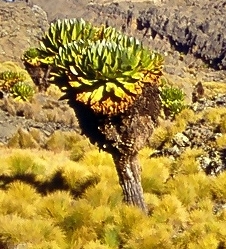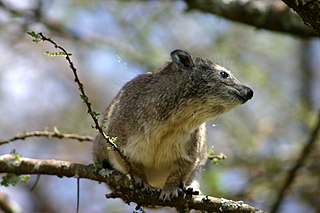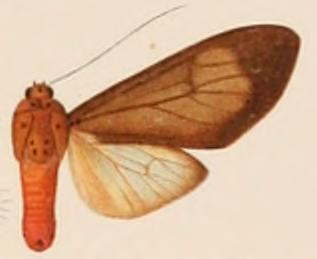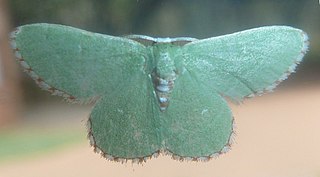
The rock hyrax, also called Cape hyrax, rock rabbit, and coney, is a medium-sized terrestrial mammal native to Africa and the Middle East. Commonly referred to in South Africa as the dassie, it is one of the five living species of the order Hyracoidea, and the only one in the genus Procavia. Rock hyraxes weigh between 4 kilograms (9 lb) and 5 kilograms (11 lb), and have short ears and tail.

Hyrax Hill is a prehistoric site near Nakuru in the Rift Valley province of Kenya. It is a rocky spur roughly half a kilometer in length, with an elevation of 1,900 meters above sea level at its summit. The site was first discovered in 1926 by Louis Leakey during excavations at the nearby Nakuru Burial Site, and Mary Leakey conducted the first major excavations between 1937 and 1938. There are two distinct areas of occupation at Hyrax Hill: one which was occupied during the Pastoral Neolithic and late Iron Age, and one which was occupied by the Sirikwa earlier in the Iron Age.

Dendrosenecio keniodendron or giant groundsel is a species of the genus Dendrosenecio of the large family Asteraceae and is one of the several species of giant groundsels endemic to the high altitudes of the Afrotropic, including Dendrosenecio johnstonii (Senecio battiscombei) occurring on Mount Kilimanjaro, Mount Kenya, and the Aberdare Mountains, Dendrosenecio keniensis occurring the lower alpine zone of Mount Kenya and D. keniodendron occurring in higher and drier sites on Mount Kenya. The giant rosette plants, sometimes 6 metres (20 ft) tall, often grow in even-sized stands, with different understory communities under different-aged stands.

The southern tree hyrax or also known as the southern tree dassie is a species of mammal in the family Procaviidae. The southern tree hyrax is mainly found in the south central eastern side of Africa.

Heterohyrax brucei, more commonly known as the yellow-spotted rock hyrax or bush hyrax, is a species of mammal in the family Procaviidae. It is found in Angola, Botswana, Burundi, Democratic Republic of the Congo, Southern Egypt, Eritrea, Ethiopia, Kenya, Malawi, Mozambique, Rwanda, Somalia, Northern South Africa, South Sudan, Sudan, Tanzania, Uganda, Zambia, and Zimbabwe. Its natural habitats are dry savanna and rocky areas. Hyrax comes from the Greek word ὕραξ, or shrew-mouse.
Binna is a monotypic genus of tiger moths in the family Erebidae. It includes one species, Binna pencillata, from West Africa and Kenya.
Robert Herbert Carcasson was an English entomologist who specialised in butterflies, but also authored two field guides to tropical fishes. He joined the Coryndon Museum, Nairobi, as senior entomologist in 1956. He then became its director, under the museum's new name of the Natural History Museum from 1961 to 1968. During this time he was awarded a PhD for his studies on African hawkmoths. From 1969 to 1971 he was Chief Curator of the Centennial Museum, Vancouver, Canada. In 1972 he travelled in Polynesia, Melanesia, Australia, Malaysia, Sri Lanka, Seychelles and East Africa for production of two field guides to coral reef fish of the Indo-Pacific region. From 1973 to 1979 he was Curator of Entomology at the Museum of British Columbia. He died of cancer. Somewhat a polymath, he was fluent in a number of languages, and produced the illustrations to a number of his works, culminating in hundreds of colour and line drawings of fishes for his reef fish field guides.
Zeuctoboarmia is a genus of moths in the family Geometridae erected by Louis Beethoven Prout in 1915.
Coniostola is a genus of moths belonging to the subfamily Olethreutinae of the family Tortricidae.
Phyllonorycter lantanae is a moth of the family Gracillariidae. It is known from South Africa and Kenya.
Conopobathra gravissima is a moth of the family Gracillariidae. It is known from India, Indonesia (Java), Malaysia (Selangor), the Bismarck Archipelago, Thailand, South Africa, Kenya, Namibia and Zimbabwe.
Apoxyptilus anthites is a species of moth in the family Pterophoridae. It is known to originate from Kenya, South Africa, Tanzania and Uganda.
Megalorhipida leptomeres is a moth of the family Pterophoridae. It is known from the Democratic Republic of Congo, Kenya, Tanzania, South Africa, La Réunion, Madagascar, the Seychelles, Oman and Yemen.

Amerila puella is a species of moth of the subfamily Arctiinae. It is found in Senegal, Sierra Leone, Ivory Coast, Ghana, Nigeria, Zaire, Uganda, Ethiopia, Kenya, Tanzania and Malawi.
Simplicia inflexalis is a litter moth of the family Erebidae. It is found in most countries of subtropical Africa, and is known from Congo, Kenya, South Africa, La Réunion, Madagascar and Mauritius.
Maxera marchalii is a moth of the family Erebidae.
The Metarbelidae are a family of the Cossoidea also called the carpenter or goat moths, and is sometimes treated as a subfamily, Metarbelinae of the Cossidae. No synapomorphies are shared with the Cossidae based on adult morphology. The family Metarbelidae was first described by Embrik Strand in 1909.

Allochrostes saliata is a species of moth in the family Geometridae. It is native to the Afrotropics, and has been recorded in Kenya, Zambia and South Africa.

Allochrostes biornata, the ornate emerald, is a species of moth in the family Geometridae described by Louis Beethoven Prout in 1913. It is native to the Afrotropics, and has been recorded in the DRC, Kenya, Mozambique, Zimbabwe, South Africa and Namibia.

The Sirikwa culture was the predominant Kenyan hinterland culture of the Pastoral Iron Age, c.2000 BP. Seen to have developed out of the Elmenteitan culture of the East African Pastoral Neolithic c.3300-1200 BP, it was followed in much of its area by the Kalenjin, Maa, western and central Kenyan communities of the 18th and 19th centuries.








